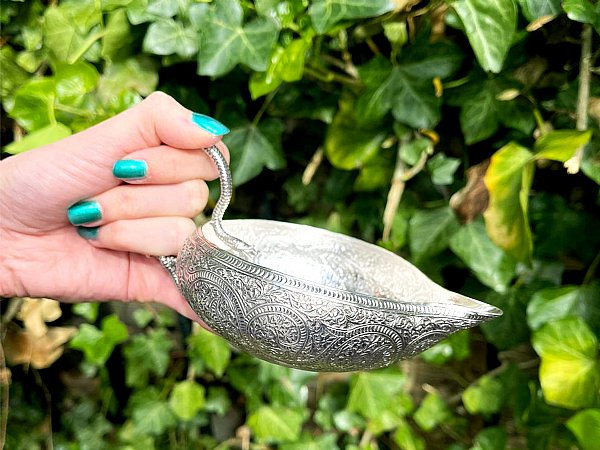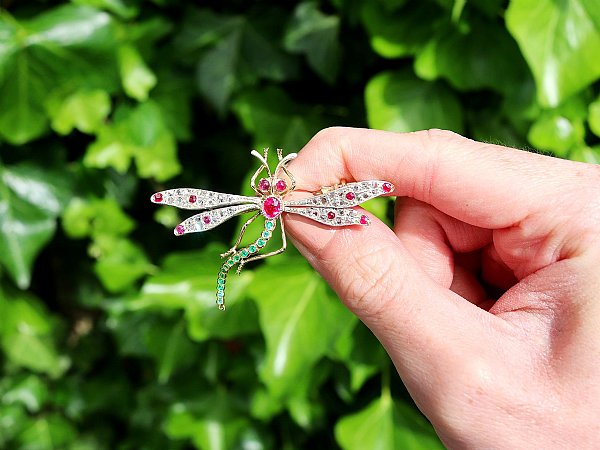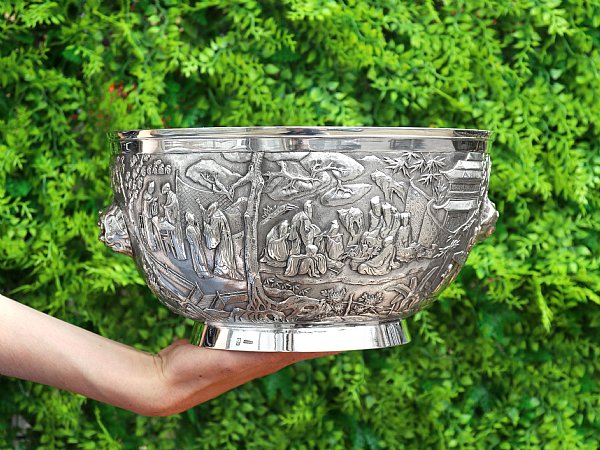Search Results for: '{{searchText}}'
Sorry...
We don't seem to have what you're looking for.
However we do have thousands of magnificent pieces of silver and jewellery available for you to view online. Browse our store using one of these categories.
Please wait for loading data... 
AC Silver is pleased to offer a fine range of antique and vintage silver cream jug sets for sale.
The diverse cream jug set collection includes pieces made in English sterling silver to jugs produced in continental silver.
Our selection of silver cream jug sets make for wonderful gifts, and are a perfect accessory in any home, as they make fantastic pieces as standalone items, or for practical use during a formal dinner service.
Andrew Campbell, using his 40 years’ experience within the antique industry, handpicks all vintage and antique silverware for sale.
Our range includes examples from the Georgian, Victorian and Edwardian eras in addition to vintage twentieth century pieces.

In 1698, in a letter to her daughter, Lady Russell described “little bottles to pour milk out for tea” exclaiming her delight at the quaintness of the very first milk bottles. By 1702, silver jugs known as ‘milk potts’ or ‘milk ewers’ were entered by the London Assay Office and by 1796 the East India Company had introduced porcelain milk jugs and pots in their cargo. Along with the use of porcelain, silver was used to make some of the first milk jugs and creamers.
The earliest examples of these were very small and narrow (about 2 ½ to 3 ½ in tall) with ‘D’ shaped handles. And sharp, beak-like spouts. They also featured a domed lid as it was the fashion to keep the milk piping hot before it was added to tea. The shape and style of the milk jug altered over time; from the original design they changed to a pear shape, then a helmet shape, then a boat shape. The lid was also discarded as trends changed towards cold milk and cream rather than hot milk.
By the turn of the 18th Century it is evident that the ritual of drinking tea with milk was becoming commonplace. Every level of society engaged in this routine, from the majority of people who would get their milk from a local dairy maid to King George III himself who had an arranged delivery of milk each day. Furthermore, the literature of the time frequently references the practice; a prime example is Duncan Campbell’s 1735 poem ‘A poem upon Tea’:Now all Philosophers agree,That Women shou’d drink MILK and TEAIt suits their constitutions best,And pleases th’unpolluted taste…
It is clear that by this point the beverage we now know as English breakfast tea had become a norm throughout British society.
By the 1760s creamers and jugs had taken on a barrel shape, with slender necks and a curling lip. It was during the 1770s however that a delightful new design of creamer was introduced by the Dutch craftsman John Schuppe. Schuppe’s design was the ‘cow creamer’ which was in the shape of a friendly cow crafted out of silver. Each part of the cow was crafted separately and then soldered together with a hinged saddle fitted as a lid and (in most cases) a small bee or a fly attached as the knob.
There are some antique designs which are so popular that they have become timeless; originating centuries ago whilst still being imitated by new items today. The cow creamer is one such design, having had iterations across many years; this bovine creamer is often made today from materials like porcelain, ceramic, and silver.
As one of the most popular designs for its purpose, the cow creamer has an established history which stretches back to the 4th century BCE.
Tea drinkers enjoyed their beverages with milk regardless of their social status, but only the wealthy elite could enjoy a full sterling silver tea service. Cream jugs were an essential component of a tea set, and for the British upper classes they were uniformly crafted from silver. The cow creamer itself was a creation of Dutch silversmith, John Schuppe, who had registered his trademark at the London Assay Office in 1753. They were produced for a very short period between 1755 and 1775 and are rare and collectable today.
In terms of their appearance the cow creamer can vary slightly, most creamers stand on four feet and a few may be fitted with grassy borders, some may have textured coats where as others have a smooth appearance. All cow creamers should have the fly hinged cover and tail handle.
Little is known about Schuppe’s origins, with it being difficult to trace if he had emigrated from Holland directly or if he was perhaps a German citizen originally; other workers in London at the time with the surname Schuppe had originated in Germany. He created the silver cow creamer design, and it was in immediately popular commodity. John Schuppe created subtle variations in his cow creamers, with some having a mirror finish on their skin, while others featured chased decoration across the entire cow to simulate its hair.
All Schuppe cow creamers are distinguishable through their curled tails which form handles, their low-slung udders, the hair decoration on their heads, and the use of an insect on their back to create a handle to open the creamer and refill it as needed. Often, the lid on the cow’s back would also be ornamented with etched floral decoration. The cow’s facial expression is usually one of cartoonish proportions, with a mouth agape to allow the milk to freely flow.
The social elite of England adored this design, and it was swiftly imitated by both other silversmiths as well as craftspeople with other specialty materials such as clay and ceramic, meaning that middle-class and working-class people soon had cow creamers of their own. The popularity of this design was such that replicas of it were crafted across England, soon being spread through Europe and North America.
Dutch and German silversmiths were those most often responsible for crafting cow creamers, with a vast majority being commissioned by members of the British upper class who had become so fond of the design.
Throughout the decades since this time, the cow-style creamer has maintained a certain level of popularity even among those who do not regularly use tea sets. While most modern-day tea-drinkers simply pour tea from the carton, there is a significant movement of those who keep their milk stored in creamers for the explicit purpose of inserting some joy and whimsy into something as mundane as a morning beverage.
Both naturalistic and stylistic interpretations of the cow creamer have been made with varying degrees of popularity, with the stylised designs giving way to more realistic ones in the early 19th century. Some notable differences can be seen in the cow’s legs, which have evolved from being very thin and spindly with rounded, flat-looking hooves to a more substantial, thicker leg with more realistic hooves.
Whatever the style or materials used to make cow creamers, they remain highly popular today both for the practical purpose of serving milk or cream in addition to the more sentimental practise of collecting antique and vintage items. Antique silver cow creamers were instantly widely-loved by Britons and Europeans alike, and today they are among the most collected types of teaware.




